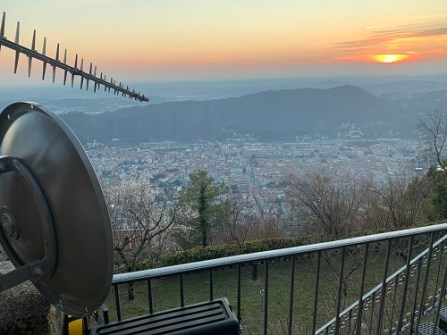
Technologies able to provide precise time and position without the use of navigation satellites, have been put to the test.
By Jon Fairall
In March, the Joint Research Centre (JRC) of the European Commission’s Directorate-General for Defence Industry and Space located in Ispra, Italy, released a report into its assessment of alternative positioning, navigation and timing technologies for potential deployment in the European Union. The tests were conducted during 2022.
The JRC reported that viable technologies exist in the private sector. Even if GNSS networks such as Galileo or GPS became unavailable, the alternate technologies would mean services could be maintained, albeit at lower levels of accuracy.
The Australian LocataLite system produced by Locata Corporation in Canberra delivered the best position results in the tests. In static tests, the JRC found that LocataLite could position to within 13 mm 95% of the time. In kinematic tests, it gave 18 mm accuracy.
Locata and six other companies, four European and two from the US, were awarded a competitive tender in October 2021 to participate in the demonstration.
Critical dependencies
Critical infrastructure systems rely heavily on GNSS services. Energy supply networks, telecommunications and financial networks depend on accurate timing signals generated by the atomic clocks that are central to GNSS. Transport and logistics as well as a myriad of consumer applications, depend on positioning.
Australian farmers can bear witness to this. In April, the SouthPAN GPS augmentation service failed due to an outage on the Inmarsat I-4 F1 satellite. The loss of service affected winter planting across Australia and New Zealand, with farming organisations claiming the damage bill could run into millions of dollars.
But that’s small beer compared to the situation overseas. The EU says GNSS underpins about €2 trillion ($1.6 billion) worth of infrastructure and has created more than 100,000 highly skilled jobs. Galileo and EGNOS (the European GPS augmentation system) have a tangible impact on many EU policy domains, such as the economy, the EU Green Deal, security and defence.
Thus, investigating the supply of alternative services, particularly ones that are locally based, is a priority. Augmentation services such as SouthPAN really do not make the cut, since they require an operational GPS to work.
All GNSS have well-known vulnerabilities. They all depend on a clear view of the sky, so they give poor results indoors and in places such as open-cut mine pits. Even when the sky can be seen, GNSS receivers can be baffled by reflections from buildings or metal structures — the so-called multi-path problem. Occasionally, the position of the satellites in the sky can result in poor geometry which leads to inaccuracies.
At a more sinister level, GNSS are all easily jammed by bad actors. And one way or another, all navigation systems are controlled by military organisations, which can degrade or shut down the service if it suits them.
Alternatives to GNSS
That’s why the JRC study compared systems that do not depend on GNSS but could be deployed in parallel with them. Timing signals provided by OPNT, Seven Solutions, SCPTime, and GMV Aerospace were examined. In addition, the study considered three full PNT providers: Satelles and NextNav from the US and Locata Corporation from Australia.
All the systems use different technologies to achieve their ends, which gives each service unique advantages and disadvantages. The report cautions that “… the diversity in both the type of the assessed technologies and the test conditions that were applied are such that benchmarking of the performances cannot be made in a fair manner. The objective of the test campaign was rather directed to characterise each technology and understand its main points of strength. In addition, it is worth stressing that, even if the technologies’ performance was evaluated against common performance indicators, some critical elements (including operation mode and implementation) cannot be captured by simple metrics.”
The main conclusion of the test campaign, according to JRC engineers, is that all platforms fulfilled the minimum requirements to be a viable substitute for any of the GNSS. More specifically, all the systems showed a timing accuracy against Coordinated Universal Time of less than a microsecond after a day’s GNSS outage. Accuracy in all systems that offered positioning capability was better than the 100 metres, horizontal and vertically, which is the same as that delivered by unaided GPS. They all showed resilience to the usual failure modes and vulnerabilities, including frequency jamming and spoofing or unintentional interference.

It is worth noting, however, that although 100 metres is the minimum guaranteed accuracy, it is hardly adequate for many applications, especially machine control.
The positioning tests showed that the Locata system can produce accuracies that are two orders of magnitude better than either the Satelles or NextNav systems. However, Locata depends on a network of specially developed ground stations called LocataLites, which produce a LocataNet. The others are intended for wide-area deployment, making them cheaper to implement for continent-wide systems.
All a matter of time
Locata’s technology is not new. The system has been under development for a decade, during which time the company has amassed 170 patents and spent more than $110 million on R&D. In the process, the company’s engineers have overcome a number of fundamental problems.
One obvious problem concerns timing. The LocataLites need to be synchronised. In the absence of a master atomic clock, how is this to be achieved? A more subtle problem is the so-called near/far problem: how to communicate effectively between the mobiles and the LocataLites when the mobile might be a few centimetres from one terminal and 100 km from the other. Locata also claims to have a solution to the multi-path problem which plagues GNSS.
The JRC test also examined Satelles’ STL (Satellite Time and Location) product. STL is designed to use existing low-Earth orbit communications satellites and conventional antennae to deliver its service. In the tests, STL delivered horizontal positioning accuracy of 27 metres and vertical accuracy of 17 metres.
The third PNT provider, NextNav, had its TerraPoiNT service put to the test. Like Locata, it requires ground-based broadcast beacons. NextNav delivers outdoor kinematic accuracy of 11 metres, according to its own publicity, but JRC engineers were unable to confirm this result.
The relative advantages and disadvantages of these systems are reflected in their customer bases. NextNav has established a large network in Los Angeles, according to its publicity. Locata has working installations in the Port of Auckland and at container terminals in the US, where it forms the basis of systems that automatically move containers from ships to ground transport, as well as various mine sites and US military installations.
In economic terms, it is probably true that GNSS’ timing signal is more valuable than positioning, given that it is now an essential part of phone, power and financial systems. The JRC conducted several tests aimed at assessing the ability of the products under test to generate a viable time signal over one day, 14 days and 100 days, and to transfer that signal over fibre, conventional wired networks and wirelessly.
OPNT has developed hardware to enable the transmission of the White Rabbit protocol over fibre. White Rabbit is a time and frequency distribution protocol developed at the European Organisation for Nuclear Research (CERN). The OPNT can deliver nanosecond time and frequency accuracy over very long distances (1,000 km).
Seven Solutions also offers a Time-as-a-Service product using White Rabbit. Its timing accuracy to UTC after 100 days is better than a nanosecond.
SCPTime disseminates UTC via conventional computer networks. In the test, the BiaTime D Premium service transmitted the time signal from the Observatoire de Paris via a server in Grenoble to the ISTIA research facility. After 24 hours, the timing accuracy was better than a microsecond.
GMV Aerospace demonstrated its WANTime project to transfer time data from Madrid to Valladolid, 130 km away. It used a passive hydrogen maser and time transfer over fibre to generate accuracy of better that a microsecond after 100 days.
Having a Plan B
The authors of the JRC report say the availability of backups should be considered a priority for the EU’s critical infrastructures, which have become primary users of positioning and timing services. It suggests developing a permanently active alternate service to increase the robustness of classical GNSS.
So far, the European Commission has issued two relevant directives. The Directive on the Resilience of Critical Entities mandates member states to identify critical infrastructures and undertake measures to strengthen their resilience. The NIS2 Directive is a similar directive aimed at thwarting cyber-attacks. Playing into this is the European Union’s current policy objective of strategic autonomy, with the Strategic Compass for Security and Defence requesting greater investment in capabilities and innovative technologies and cooperation with partners.












